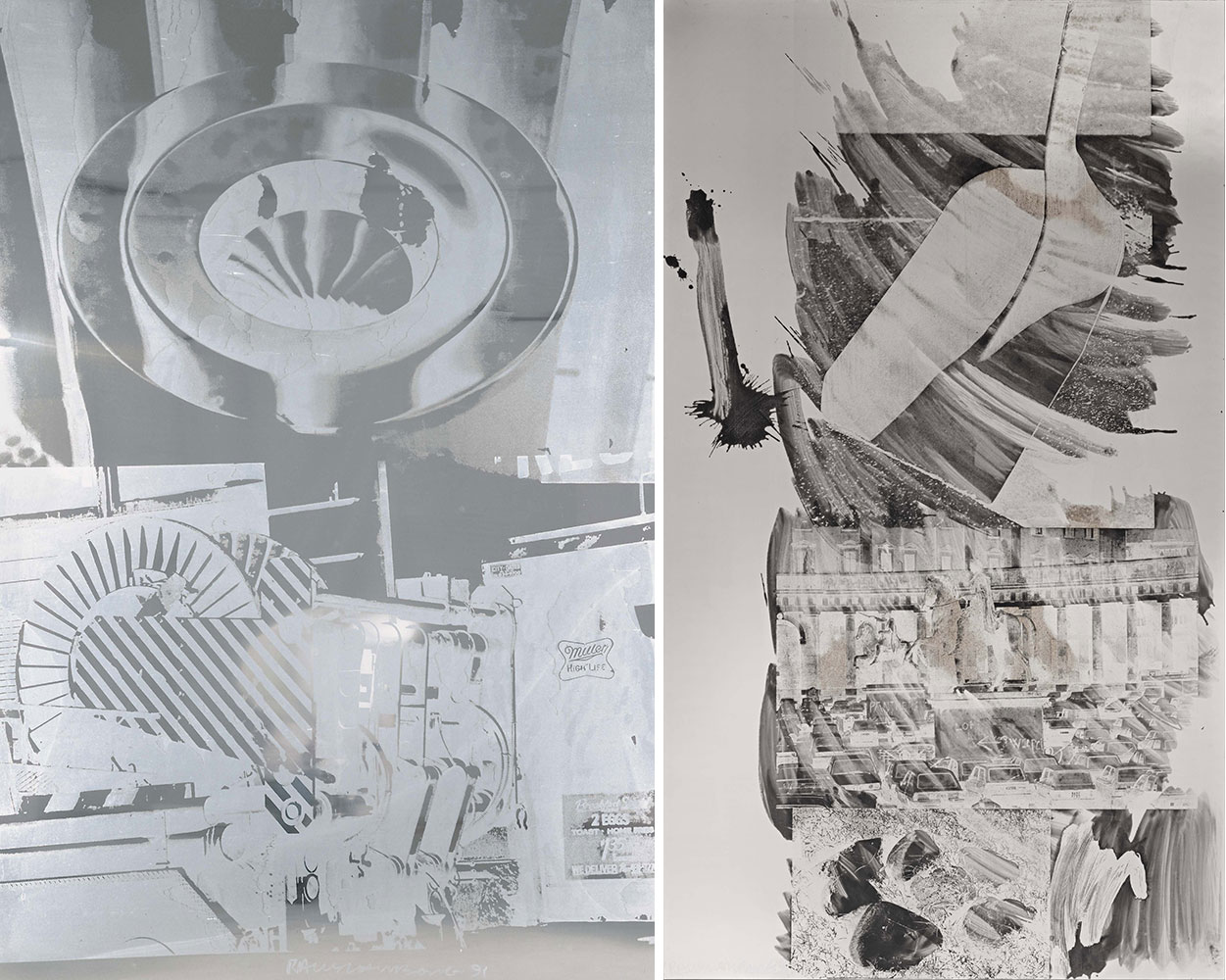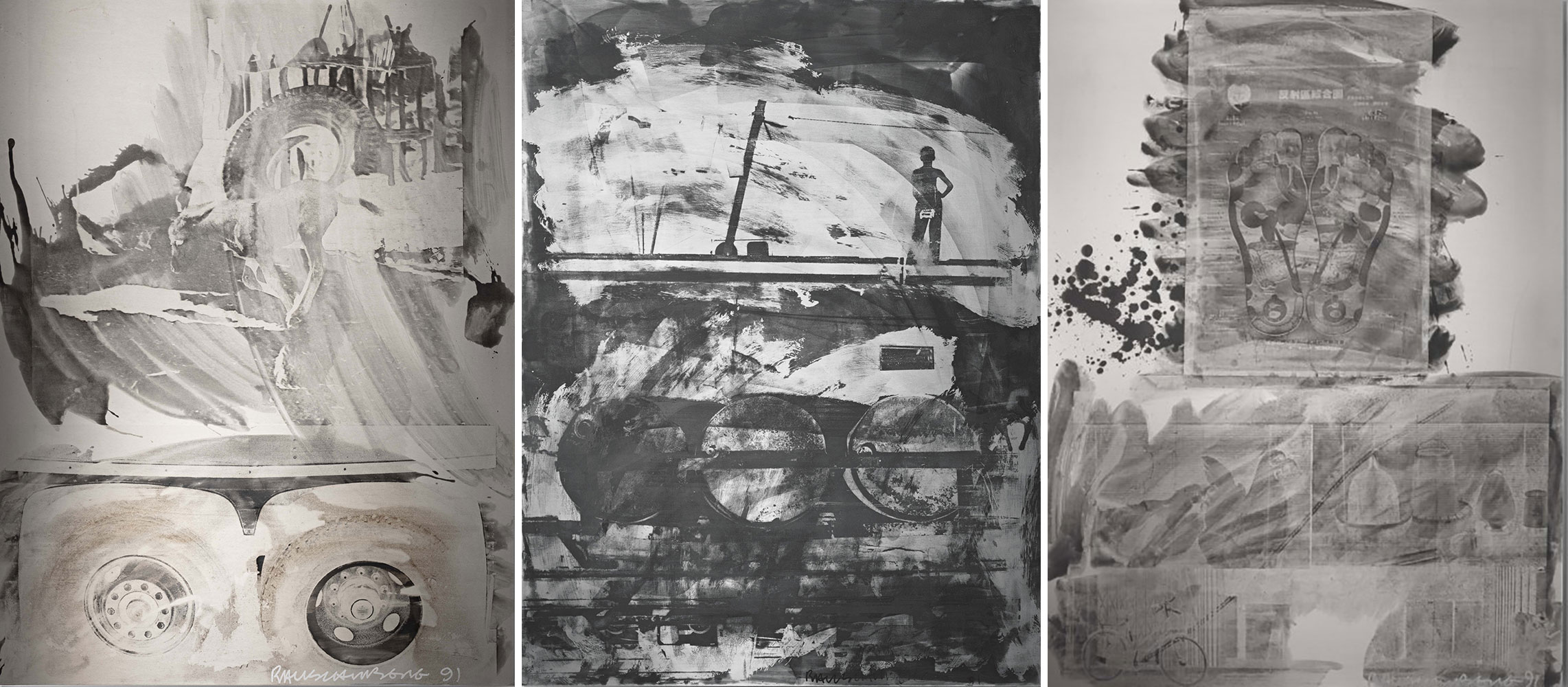ART CITIES:Paris-Robert Rauschenberg
 Over the course of his sixty-year long career, Robert Rauschenberg was inspired by wide-ranging experiences, collaborations, and a spirit of experimentation with new materials and techniques. Although he demurred affiliation with any specific movement, he has been identified as a forerunner of practically every post-war artistic development since Abstract Expressionism.
Over the course of his sixty-year long career, Robert Rauschenberg was inspired by wide-ranging experiences, collaborations, and a spirit of experimentation with new materials and techniques. Although he demurred affiliation with any specific movement, he has been identified as a forerunner of practically every post-war artistic development since Abstract Expressionism.
By Efi Michalarou
Photo: Galerie Thaddaeus Ropac Archive
Robert Rauschenberg’s series “Night Shades” and “Phantoms” from 1991 are on show at Galerie Thaddaeus Ropac, these are two series of metal paintings composed of silk-screened photographic images and gestural strokes on aluminium supports. Made during his decade-long experimentations with metal, these paintings are characterised by their grayscale palette, which ranges from the “Night Shades” painterly chiaroscuro to the “Phantoms” mirrored surfaces and ethereal translucency. Rauschenberg creates dream-like imagery which appears and disappears as a result of light, shadows and reflections across the artworks’ surfaces. One of the most influential artists of the twentieth century, Rauschenberg revolutionised the picture plane by bringing together painting, photography and sculpture in a highly inventive way. From the mid-1980s onwards, following his sojourn in Chile, he swapped canvas for sheets of first copper, then brass, bronze and in the case of the “Night Shades” and “Phantoms”, brushed and mirrored aluminium. Rauschenberg’s use of metal can be traced back to his earlier sculptural assemblages made with industrial waste and scrap metal, as in his “Elemental Sculptures” (1953/59), as well as in his “Combines” (1954–64) and his later “Gluts” (1986–89/1991–94). In the “Night Shades” and “Phantoms”, Rauschenberg used metal as a pictorial device that references the reality of an industrialised world while also serving as a reflective surface that captures images, impressions and memories. For the “Night Shades”, Rauschenberg silkscreened images onto mirrored or brushed aluminium, applying a tarnish called Aluma Black with gestural strokes. At times the images are obscured by the tarnish, leaving expressive spills of black; at others, Rauschenberg mixed varnish with pigments which resist the tarnish and further enhance the works’ painterly qualities. For the “Phantoms”, Rauschenberg experimented with a different type of metal – mirrored, anodised aluminum – which repelled the tarnish, producing spectral images that appear or disappear according to one’s viewpoint. Therefore, the “Phantoms” developed from the “Night Shades” as an almost ghostly double. Their title alludes to their phantasmagoric effect, while the term “Night Shades” refers to a poisonous plant that bears dark berries; as a compound word it also suggests twilight or a curtain falling. The images used in the silkscreening process are Rauschenberg’s own photographs, taken during his various trips across the United States and abroad between 1979 and 1991, including his travels for the “Rauschenberg Overseas Culture Interchange” (ROCI) project (1984–91), which aimed to achieve mutual understanding between different cultures across the globe through creative exchanges. By bringing together disparate elements from a variety of sources and locations within the same picture plane, Rauschenberg communicates a desire for interconnectedness. The elements are combined in compositions that are poetic and witty, encouraging the viewer to create their own associations between images and words. The iconography is extremely rich and varied. Snapshots of urban life as well as historical and cultural artefacts such as the Berlin Wall or a temple in Malaysia, are juxtaposed with images of trees, plants and fauna, and at times combined with gestural marks that emphasise a sense of vitality and movement. And yet, the images can be difficult to grasp, their evanescence and layering also suggesting the elusiveness of memory. Rauschenberg’s process of incorporating his own photographs of past impressions and experiences also suggests a self-reflective and retrospective approach. It is perhaps not a coincidence that in 1991, the same year the “Night Shades” and “Phantoms” were made, Rauschenberg was the subject of major exhibitions spanning his career, presented at the Whitney Museum of American Art, New York; the National Gallery of Art, Washington, D.C; and the Menil Collection, Houston.
Info: Galerie Thaddaeus Ropac, 7 rue Debelleyme, Paris, Duration: 22/10-5/12/20, Days & Hours: Tue-Sat 10:00-19:00, www.ropac.net







Right: Robert Rauschenberg, Neapolitan Excavation (Night Shade), 1991, Tarnish and silkscreen ink on mirrored aluminum, 213.4 x 122 cm, Courtesy Robert Rauschenberg Foundation & Galerie Thaddaeus Ropac

Right: Robert Rauschenberg, Office Break (Phantom), 1991, Silkscreen ink on anodized mirrored aluminum, 123.2 x 61.1 cm, Courtesy Robert Rauschenberg Foundation & Galerie Thaddaeus Ropac

Center: Robert Rauschenberg, Drums (Night Shade), 1991, Tarnish and silkscreen ink on brushed aluminum, 121,9 x 91,2 cm, Courtesy Robert Rauschenberg Foundation & Galerie Thaddaeus Ropac
Right: Robert Rauschenberg, Path (Night Shade), 1991, Tarnish and silkscreen ink on brushed aluminum, 122 x 91.4 cm, Courtesy Robert Rauschenberg Foundation & Galerie Thaddaeus Ropac
